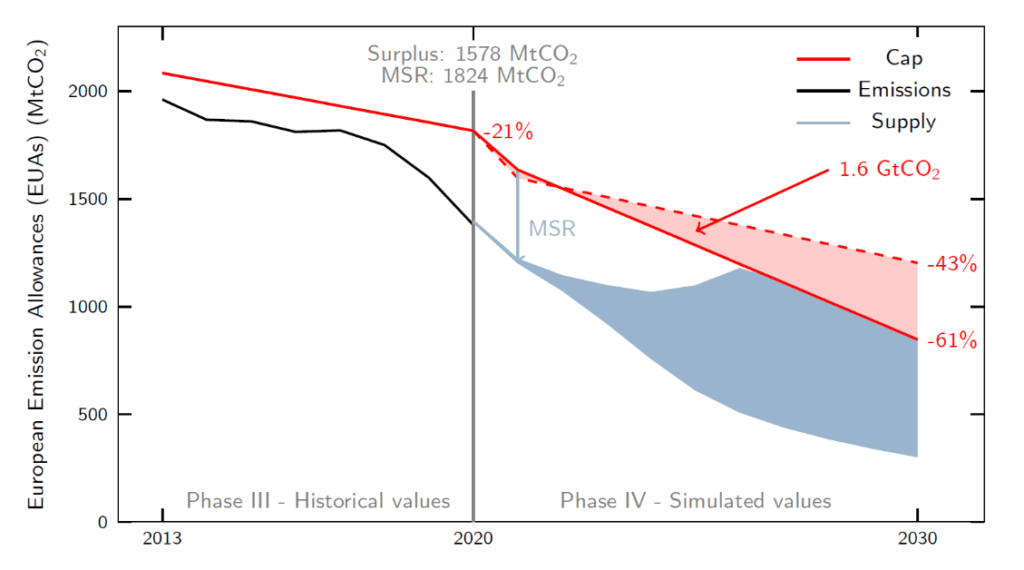A post by Kenneth Bruninx (University of Leuven) and Marten Ovaere (Ghent University)
The European Union Emissions Trading System (EU ETS) is a key policy instrument to support the cost-efficient transition to a carbon-neutral society. It puts a binding, annually reducing cap on emissions from the power sector, energy-intensive industry and intra-EU aviation, enforced via tradable emission allowances (EUAs).
Since 2019, a quantity-based supply adjustment mechanism, the Market Stability Reserve (MSR), increases or decreases the supply of EUAs depending on the cumulative difference between the supply of EUAs and emissions, referred to as the ‘surplus’, ‘bank’ or total number of allowances in circulation (TNAC). If the surplus exceeds a threshold, part of the to-be-auctioned EUAs are placed in the MSR. Vice versa, if the surplus falls below a lower threshold, part of the holdings of the MSR are auctioned. As of 2023, an invalidation rule is in effect, limiting the holdings of the MSR, effectively lowering the cumulative emissions cap. In its Fit for 55 Package, the European Commission (EC) proposed to increase the linear reduction factor to 4.2%, reducing the cumulative cap between 2021 and 2030 by 1.6 GtCO2 (red area in Figure 1) and maintain the invalidation rule of the MSR, such that cumulative EUA supply is strictly below the cumulative cap. The effective supply of EUAs is, however, uncertain and depends, i.a., on future emissions (blue area in Figure 1).

Figure 1: Illustration of decreased cumulative EUA supply because of increased LRF (-1.6 GtCO2) and MSR invalidations. The exact supply of EUAs (blue area) is uncertain and depends, i.a., on future emissions. This illustration considers the MSR design as proposed by the EC in its Fit for 55 proposal.
In our latest paper [1], we explain these mechanisms in detail for the current and the proposed EU ETS design and simulate the effect of COVID-19, the European Green Deal, and the recovery stimulus package on cumulative EU ETS emissions and allowance prices. We find that aligning EU ETS with the 2030 reduction target of -55% (-61% for EU ETS, relative to 2005) increases allowance prices to 45 – 94 €/ton CO2 today and reduces cumulative EU ETS CO2 emissions to 14.2 – 18.3 GtCO2 compared to 23.5 – 33.1 GtCO2 under a -40% 2030 reduction target. This indicates that current EUA price levels are supported by market fundamentals.
The EU ETS’ invalidation rule also implies that shocks and overlapping policies can change cumulative EU ETS emissions. As the invalidation volumes in the current and proposed MSR design are conditional on the ‘surplus’, any overlapping policy affecting emission allowance demand may lead to changes in cumulative EU ETS emissions, an effect referred to as waterbed leakage. This may result in backfiring overlapping policies (e.g., announced future closures of coal-fired power plants that increase cumulative ETS emissions) – a new Green Paradox. For the MSR design proposed in the Fit for 55 Package, we find that overlapping policies may affect cumulative emissions more than proportionally due to an interaction between the changes to the MSR intake rate, the TNAC definition, and the timing of the MSR’s supply adjustments. In other words, overlapping policies may reduce or increase cumulative EU ETS emissions more than the policy-induced EUA demand change, even when they backfire.
Waterbed leakage of any overlapping policy is fundamentally uncertain and crucially depends on when the waterbed will be sealed again, which is an endogenous market outcome driven by exogenous shocks (e.g. future commodity prices) and overlapping climate policies, like European and National energy and climate policies.
As an alternative, price-based supply adjustment mechanisms hold a similar trade-off between stabilizing prices versus quantities, but they don’t lead to waterbed leakage of overlapping policies. The MSR design proposed by the EC can be improved by accounting for future EUA supply adjustments in the TNAC definition, but this quantity-based supply adjustment mechanism would still yield waterbed leakage for overlapping policies and shocks.
[1] This blog post is based on the article:
- Bruninx, K., Ovaere, M. (2022). COVID-19, Green Deal and recovery plan permanently change emissions and prices in EU ETS Phase IV. Nature Communication, 13, 1165. https://www.nature.com/articles/s41467-022-28398-2
Kenneth Bruninx and Marten Ovaere are both supported by the Research Foundation Flanders (FWO), mandate no. 12B7822N and mandate no. 12J3320N.
The views and opinions expressed in this post are solely those of the author(s) and do not reflect those of the editors of the blog of the project LIFE DICET.

